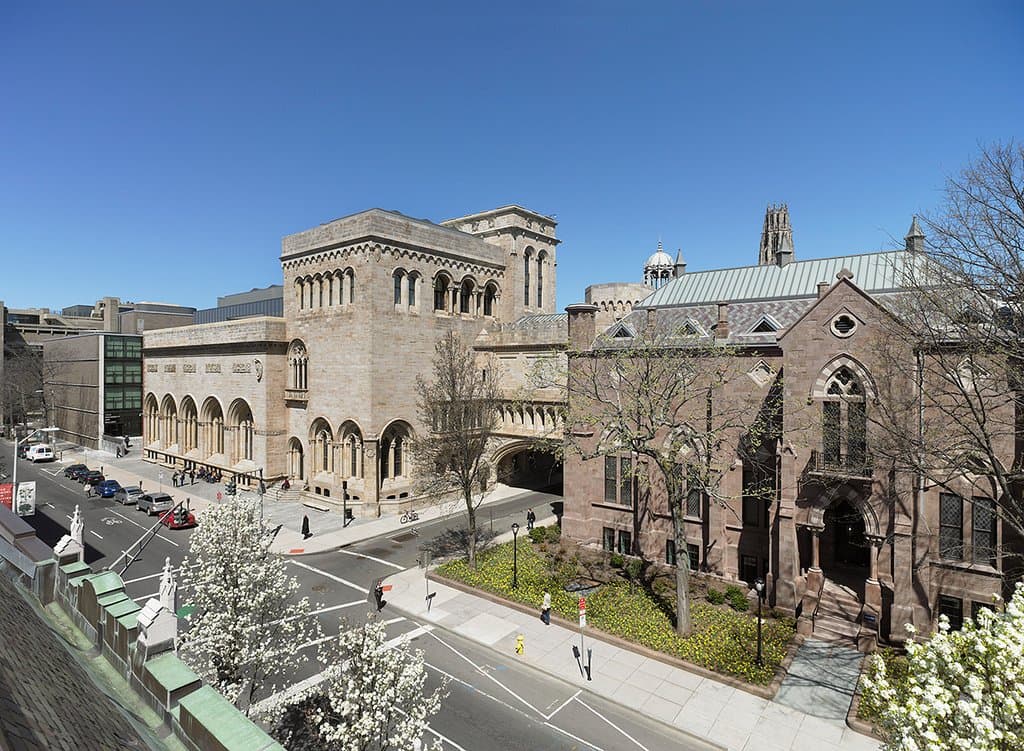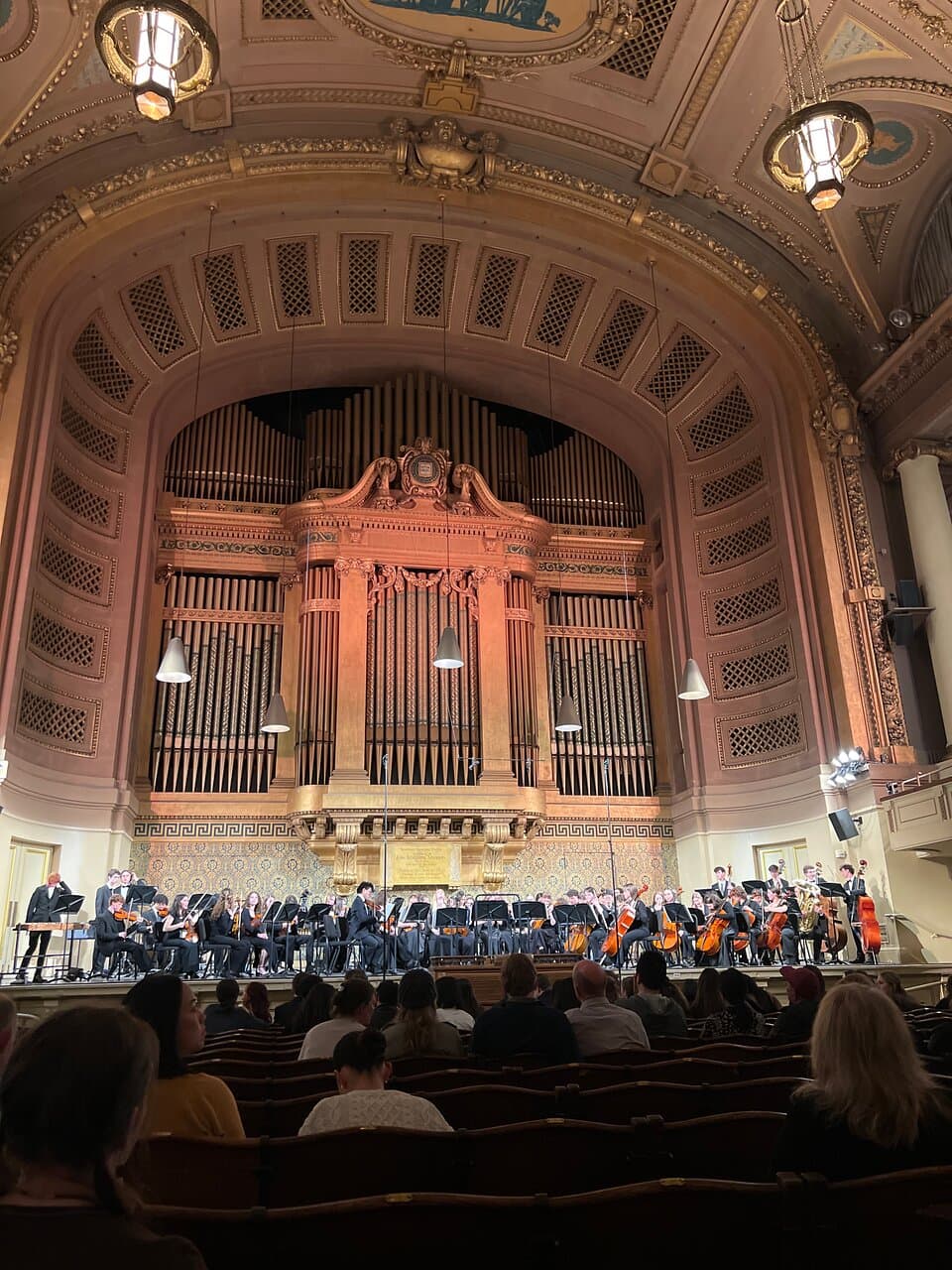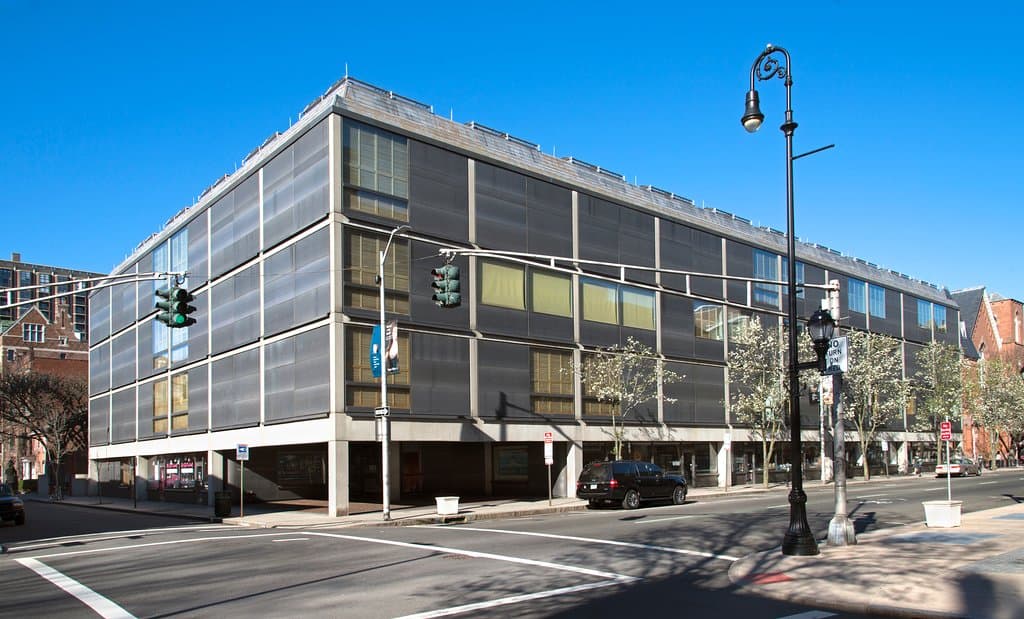Hewitt University Quadrangle (Beinecke Plaza)
Isamu Noguchi's sunken garden at Beinecke Plaza, a masterpiece of minimalist design blending art, light, and function.
Highlights
Must-see attractions

Social
From TikTok & Reddit
Best Time
Serene atmosphere, perfect light
Hewitt University Quadrangle (Beinecke Plaza)
Best Time
Serene atmosphere, perfect light
Highlights
Must-see attractions
Isamu Noguchi's sunken garden at Beinecke Plaza, a masterpiece of minimalist design blending art, light, and function.
"A mesmerizing interplay of light, shadow, and geometric precision that transforms a functional necessity into art. "
🚶♂️ Embrace Contemplation
This space is designed for reflection, not just passing through. Take time to appreciate the art and its function. :thought_balloon:
☀️ Watch the Light Play
The plaza's beauty changes dramatically with the sun. Visit at different times to see the light and shadow transform the space. :sunriseovermountains:
Highlights
Discover the most iconic attractions and experiences
Isamu Noguchi's Sunken Garden
Beinecke Rare Book & Manuscript Library
A mesmerizing interplay of light, shadow, and geometric precision. Noguchi's minimalist vision transforms a functional space into art.
The Circular Sculpture
Center of the sunken garden
A singular white form anchoring the plaza, creating a focal point and counterpoint to the surrounding geometries.
Marble Plaza's Incised Circles
The plaza surface
Rippling outward like frozen stone waves, these patterns invite contemplation and add to the garden's dynamic feel.
Plans like a pro.
Thinks like you
Planning Your Visit
Timing Your Visit to Beinecke Plaza
Understanding the Beinecke Plaza Experience
Best Times
Insider Tips
from TikTok, Instagram & Reddit
🚶♂️ Embrace Contemplation
This space is designed for reflection, not just passing through. Take time to appreciate the art and its function. :thought_balloon:
☀️ Watch the Light Play
The plaza's beauty changes dramatically with the sun. Visit at different times to see the light and shadow transform the space. :sunriseovermountains:
📸 Capture the Geometry
The clean lines and circular motifs make for stunning photography. Experiment with angles to highlight Noguchi's design. :camerawithflash:
📚 Connect to the Library
Remember this plaza serves the Beinecke Library. Consider a visit to the library itself for a complete experience.
Tips
from all over the internet
🚶♂️ Embrace Contemplation
This space is designed for reflection, not just passing through. Take time to appreciate the art and its function. :thought_balloon:
☀️ Watch the Light Play
The plaza's beauty changes dramatically with the sun. Visit at different times to see the light and shadow transform the space. :sunriseovermountains:
📸 Capture the Geometry
The clean lines and circular motifs make for stunning photography. Experiment with angles to highlight Noguchi's design. :camerawithflash:
📚 Connect to the Library
Remember this plaza serves the Beinecke Library. Consider a visit to the library itself for a complete experience.
What Travellers Say
Reviews Summary
Visitors consistently praise Beinecke Plaza for its stunning minimalist design and the masterful integration of art and function by Isamu Noguchi. The interplay of light and shadow, the geometric patterns, and the serene atmosphere are frequently highlighted as major draws. Some note that it's a space best appreciated for quiet contemplation rather than active recreation.
"In the shadows of Yale's campus, Isamu Noguchi's sunken garden at the Beinecke Rare Book & Manuscript Library performs an architectural pas de deux between light and shadow, history and modernity. The garden, captured here in evening light, demonstrates how Noguchi's minimalist vision transforms a functional necessity - bringing natural light to the library's underground spaces - into a meditation on geometric precision and natural form.
The signature elements reveal themselves gradually: The marble plaza's incised circles ripple outward like stone waves frozen in time, while a singular sculptural element (the white circular form) serves as both anchor and counterpoint to the rigid geometries surrounding it. This is classic Noguchi - the tension between organic and ordered forms playing out in monumental scale.
The garden's genius lies in its multi-layered functionality:
- As a light well, it bathes the library's underground reading rooms in filtered natural light
- As a sculpture court, it provides an outdoor gallery for contemplation
- As an architectural device, it creates a visual bridge between the modernist intervention below and the classical architecture above
The surrounding glass walls act as a membrane between interior and exterior space, their transparency heightened at night when interior lighting transforms them into glowing vitrines. This interplay would have delighted Noguchi, who consistently sought to blur the boundaries between contained and containing spaces.
The safety concerns that might preoccupy contemporary architects (drainage, fall protection, maintenance) were elegantly addressed in the original design through subtle grade changes and strategic barrier placement. Yet the space retains its essential openness, a rare quality in today's more risk-averse architectural climate.
While the plaza might tempt New Haven's vibrant skateboarding community (the smooth marble surfaces and geometric patterns recall the celebrated modernist plazas of Barcelona), its primary role remains contemplative. The space works best for small picnics, impromptu seminars, or solitary reflection, activities that honor both its artistic significance and its role as a threshold to one of America's great research libraries.
Like the rare manuscripts housed above, Noguchi's garden rewards close reading. Each visit reveals new details: the way moonlight catches the circular sculpture's edges, how winter snow fills the incised patterns, or how the space frames the changing seasons through its careful orchestration of views upward to sky and trees.
This is public art of the highest order - sophisticated yet accessible, functional yet transcendent, and perhaps most importantly, as relevant today as when it was first conceived nearly six decades ago."
Jeremy Edmunds
"Looks beautiful"
Nico Samneil Salado
""
JD Arquitetura & Interiores
What People Like
What People Dislike
Frequently Asked Questions
🚇 🗺️ Getting There
Hewitt University Quadrangle, home to Beinecke Plaza, is located at Yale University in New Haven, CT. You can reach it by car, public transport, or by walking if you are already on campus. Parking can be challenging in New Haven, so consider using ride-sharing services or public transit.
Yes, New Haven has a bus system that can take you close to Yale University. The plaza is centrally located on campus, making it easily accessible once you arrive in the city.
Parking near Yale University can be limited and expensive. There are several parking garages in the vicinity, such as the Broadway Garage or the Crown Street Garage. It's advisable to check Yale's visitor parking information for the most up-to-date options.
Beinecke Plaza is an outdoor public space and is generally accessible during daylight hours. However, it's best to check Yale University's campus access policies for any specific restrictions or hours.
Absolutely! Beinecke Plaza is a central and visually striking part of Yale's campus, making it an excellent starting point for a self-guided tour or to get a feel for the university's architecture.
🎫 🎫 Tickets & Entry
No, Beinecke Plaza is an outdoor public space and does not require an admission ticket. You can freely walk through and admire the architecture and sculpture.
There are no fees to visit Beinecke Plaza itself. Any costs would be related to transportation or parking in the area.
Yes, the Beinecke Plaza is the entrance to the Beinecke Rare Book & Manuscript Library. Visitors are welcome to enter the library during its operating hours, though access to certain collections may be restricted.
As an outdoor public space, Beinecke Plaza is generally accessible during daylight hours. The Beinecke Library itself has specific operating hours, which you can find on their official website.
Beinecke Plaza is beautiful year-round. However, visiting during spring or fall offers pleasant weather for exploring. The changing seasons can also add a unique visual element to Noguchi's design.
🎫 ✨ Onsite Experience
Beinecke Plaza is primarily a space for contemplation and appreciation of Isamu Noguchi's sunken garden design. You can admire the sculptures, the marble plaza, and the architecture of the Beinecke Library. It's ideal for photography and quiet reflection.
Yes, Beinecke Plaza is a photographer's dream! The geometric patterns, the interplay of light and shadow, and the minimalist sculptures offer incredible opportunities for striking shots.
While not explicitly designated as a picnic area, small, respectful gatherings like picnics are generally tolerated, especially during off-peak hours. However, be mindful of the space's artistic and contemplative nature.
Children can visit Beinecke Plaza, but it's important to supervise them closely due to the sunken garden's design and the presence of marble. It's more of a place for quiet observation than active play.
The sunken garden, designed by Isamu Noguchi, serves as a light well for the Beinecke Library's underground reading rooms, bringing natural light to the subterranean spaces. It's also a significant piece of public art.
📸 📸 Photography
The best times for photography are during the 'golden hours' – shortly after sunrise and before sunset – when the light creates dramatic shadows and highlights. Evenings can also be magical when the library is lit from within.
Beinecke Plaza is ideal for architectural photography, minimalist photography, and capturing the interplay of light and shadow. The geometric patterns and sculptural elements offer endless creative possibilities.
Generally, casual photography for personal use is permitted. However, professional or commercial photography may require permits. It's always a good idea to check with Yale University or the Beinecke Library if you plan extensive shoots.
A wide-angle lens is great for capturing the expanse of the plaza and its architectural context. A prime lens can be useful for isolating details of the sculptures or patterns. A tripod can help with low-light photography.
To capture the light well effect, try shooting from the plaza level looking down into the library's underground spaces, or from within the library looking up towards the plaza. Experiment with different exposures to highlight the contrast between light and shadow.
For Different Travelers
Tailored advice for your travel style
👨👩👧 Families with Kids
Keep an eye on younger children, as the sunken garden has open edges. Consider it a brief, enriching stop on a larger campus tour. The nearby Sterling Memorial Library also has impressive architecture that might appeal to older children interested in grand buildings.
📸 Photography Enthusiasts
Pro-tip: Visit during the golden hour for the most dramatic lighting. Experiment with wide-angle lenses to capture the scale and symmetry, and consider a tripod for low-light evening shots when the library is illuminated from within.
🏛️ Architecture & Art Lovers
Pair your visit with a tour of the Beinecke Rare Book & Manuscript Library itself, a modernist masterpiece designed by Gordon Bunshaft, to fully appreciate the architectural context and the intellectual heart of Yale.
Deep Dives
In-depth insights and expert knowledge
Isamu Noguchi's Vision for Beinecke Plaza
The plaza's design is characterized by its incised circles that ripple outward, creating a sense of movement and depth. This 'sunken garden' effect not only illuminates the library's reading rooms but also provides a serene outdoor space for contemplation. The surrounding glass walls of the library act as a membrane, blurring the lines between interior and exterior, especially at night when the interior lights create a warm glow. This thoughtful integration of art, architecture, and function is what makes Beinecke Plaza a unique and celebrated space on the Yale campus.
Noguchi's work here exemplifies his philosophy of creating art that is accessible and integrated into daily life. The plaza is a space that rewards close observation, with subtle details revealing themselves upon repeated visits. It's a place where visitors can pause, reflect, and appreciate the harmonious coexistence of form and purpose, a rare quality in urban design.
Experiencing Beinecke Plaza: A Photographer's Paradise
Visiting during the 'golden hours' – early morning or late afternoon – is highly recommended. The low-angle sunlight casts long, dramatic shadows, accentuating the plaza's architectural features and creating a dynamic visual narrative. Evenings offer a different kind of beauty, as the interior lights of the Beinecke Library illuminate the glass walls, turning the plaza into a glowing beacon.
When composing your shots, consider playing with different perspectives. Look for symmetry, leading lines created by the plaza's geometry, and the interplay between the plaza and the surrounding Yale architecture. The minimalist nature of the design means that even simple compositions can be incredibly powerful. Don't forget to capture the details – the texture of the marble, the subtle curves of the incised patterns, and the reflections in the glass.
The Beinecke Library: A Jewel Box of Rare Books
Inside, visitors can marvel at the library's vast collection, which includes Gutenberg Bibles, original manuscripts from renowned authors, and historical documents. While access to the stacks is restricted, the library often has public exhibitions showcasing its treasures. The building's design, with its open interior and the central tower, creates a sense of awe and reverence for the knowledge contained within.
Visiting the Beinecke Library after experiencing the tranquility of Beinecke Plaza offers a comprehensive appreciation of Yale's commitment to scholarship and art. The plaza and the library are intrinsically linked, each enhancing the experience of the other, making it a must-visit for anyone interested in architecture, art, and history.




Social
from TikTok, Instagram & Reddit